Multinational Companies are known to create wealth
VerifiedAdded on 2022/09/18
|18
|4093
|22
AI Summary
Contribute Materials
Your contribution can guide someone’s learning journey. Share your
documents today.
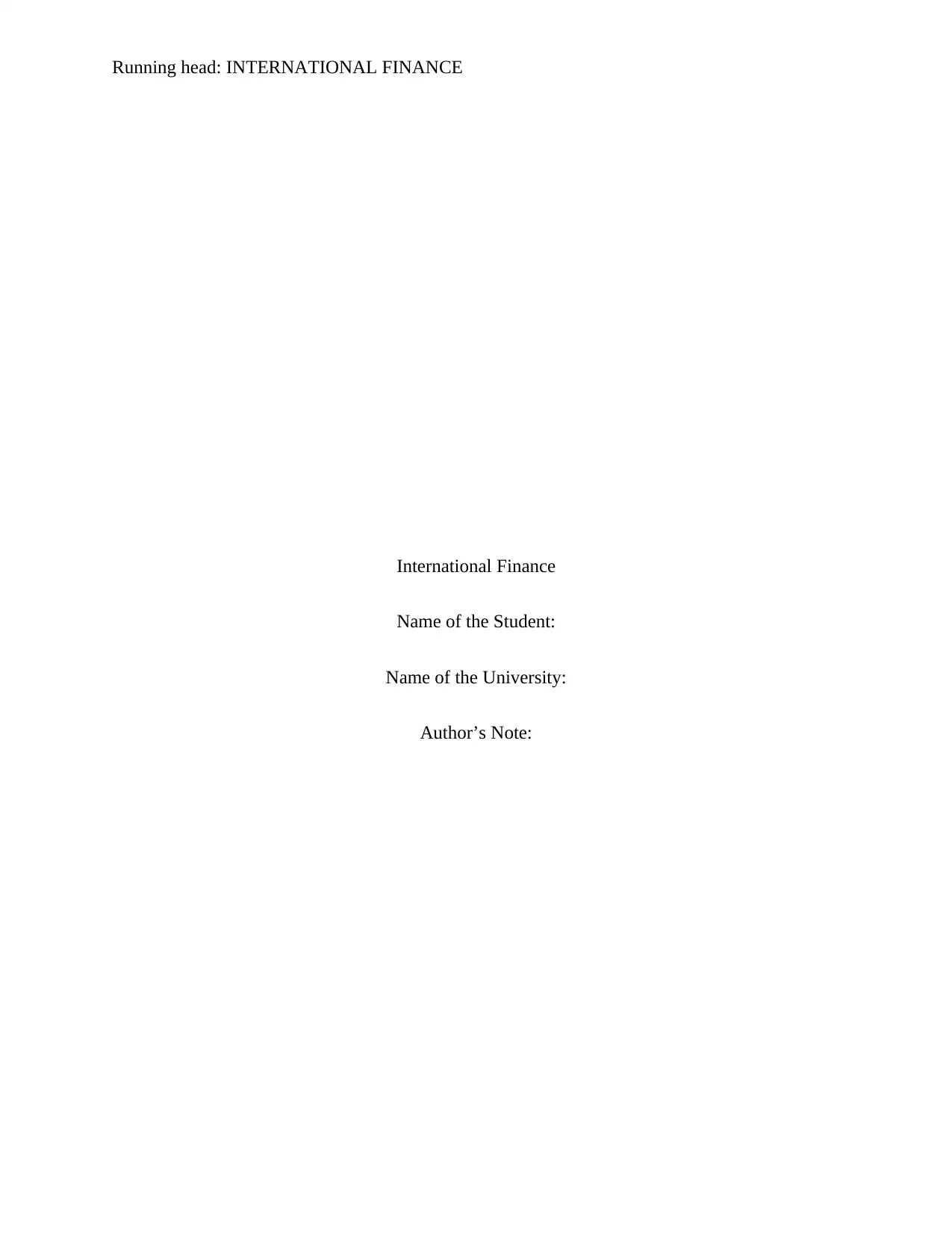
Running head: INTERNATIONAL FINANCE
International Finance
Name of the Student:
Name of the University:
Author’s Note:
International Finance
Name of the Student:
Name of the University:
Author’s Note:
Secure Best Marks with AI Grader
Need help grading? Try our AI Grader for instant feedback on your assignments.
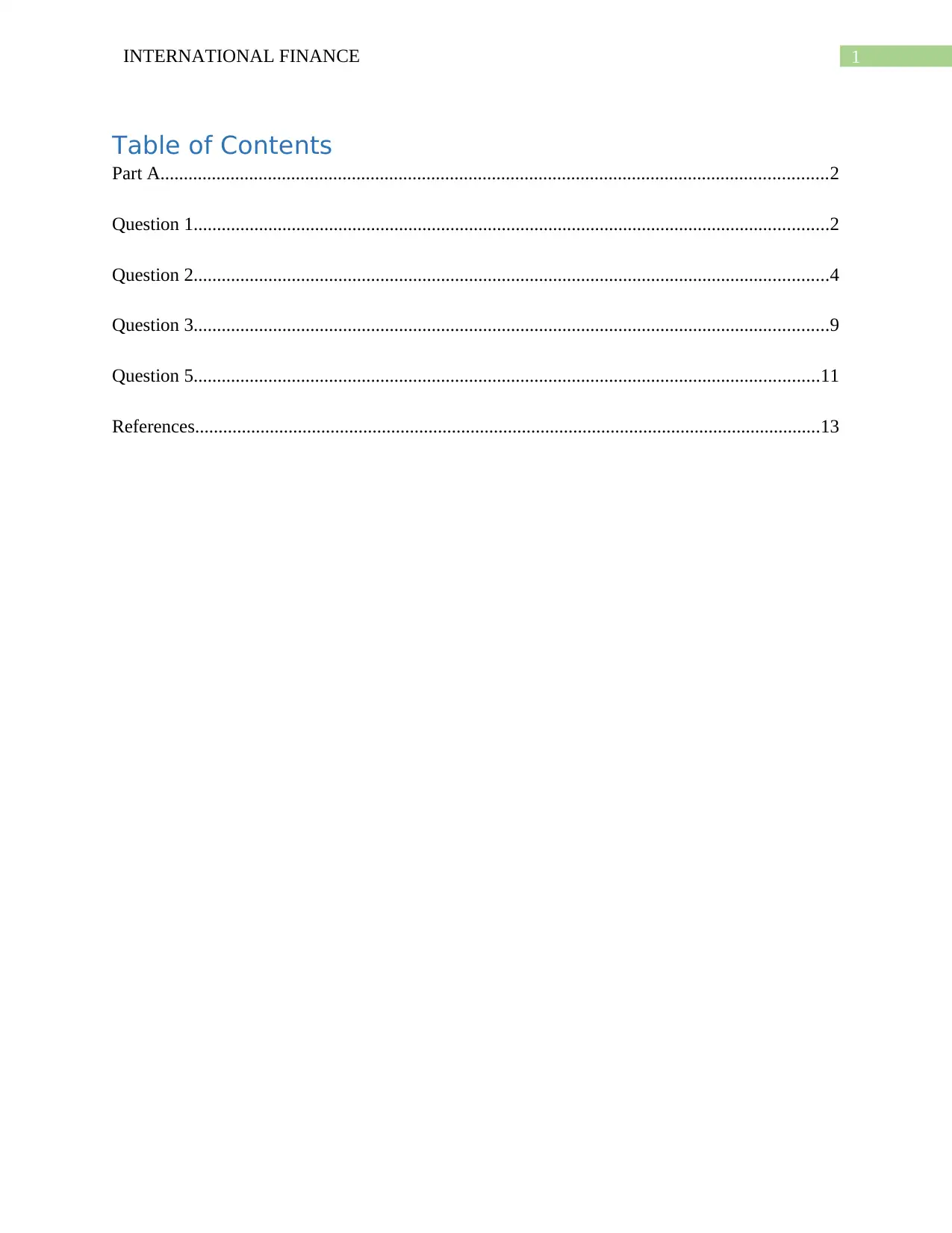
1INTERNATIONAL FINANCE
Table of Contents
Part A...............................................................................................................................................2
Question 1........................................................................................................................................2
Question 2........................................................................................................................................4
Question 3........................................................................................................................................9
Question 5......................................................................................................................................11
References......................................................................................................................................13
Table of Contents
Part A...............................................................................................................................................2
Question 1........................................................................................................................................2
Question 2........................................................................................................................................4
Question 3........................................................................................................................................9
Question 5......................................................................................................................................11
References......................................................................................................................................13
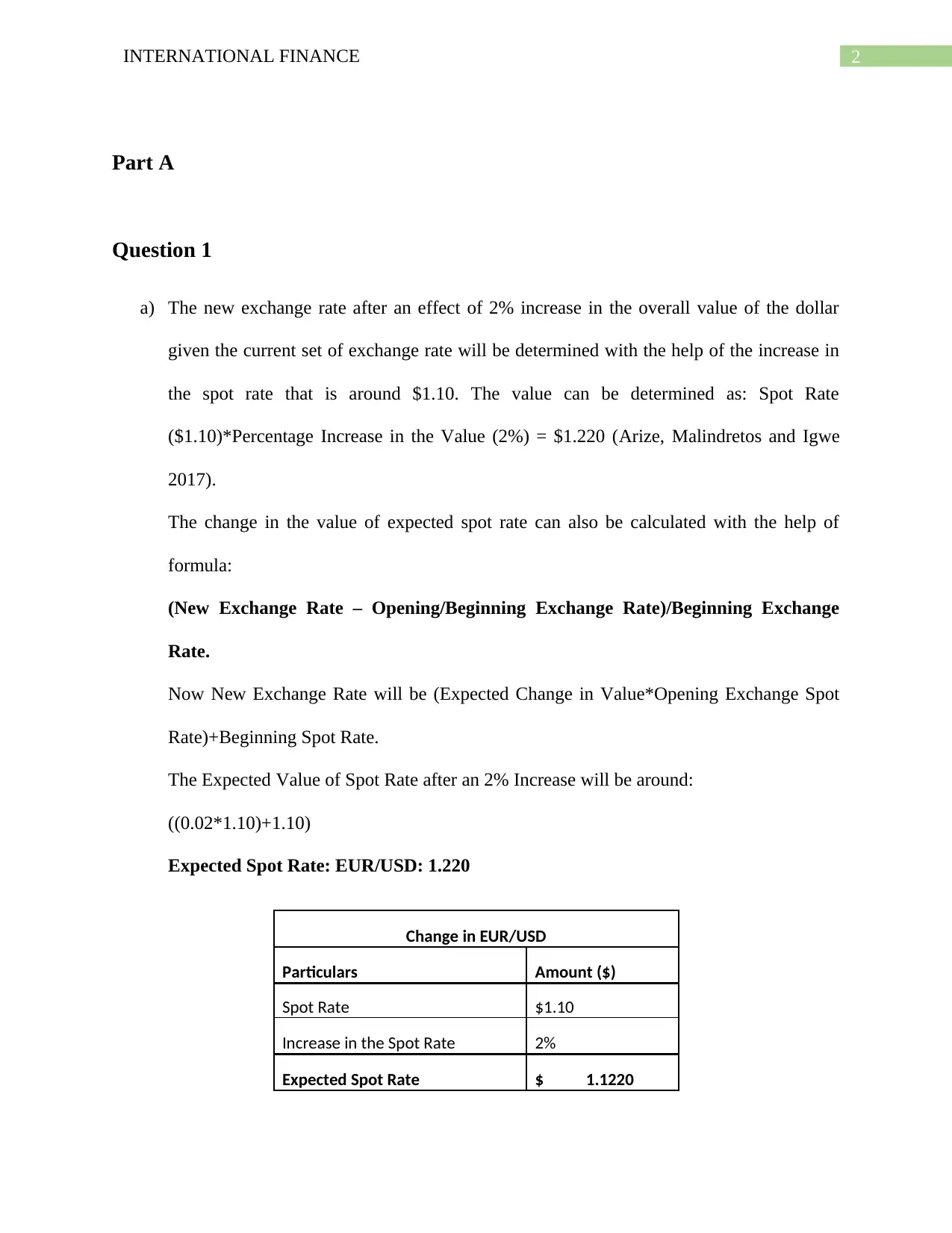
2INTERNATIONAL FINANCE
Part A
Question 1
a) The new exchange rate after an effect of 2% increase in the overall value of the dollar
given the current set of exchange rate will be determined with the help of the increase in
the spot rate that is around $1.10. The value can be determined as: Spot Rate
($1.10)*Percentage Increase in the Value (2%) = $1.220 (Arize, Malindretos and Igwe
2017).
The change in the value of expected spot rate can also be calculated with the help of
formula:
(New Exchange Rate – Opening/Beginning Exchange Rate)/Beginning Exchange
Rate.
Now New Exchange Rate will be (Expected Change in Value*Opening Exchange Spot
Rate)+Beginning Spot Rate.
The Expected Value of Spot Rate after an 2% Increase will be around:
((0.02*1.10)+1.10)
Expected Spot Rate: EUR/USD: 1.220
Change in EUR/USD
Particulars Amount ($)
Spot Rate $1.10
Increase in the Spot Rate 2%
Expected Spot Rate $ 1.1220
Part A
Question 1
a) The new exchange rate after an effect of 2% increase in the overall value of the dollar
given the current set of exchange rate will be determined with the help of the increase in
the spot rate that is around $1.10. The value can be determined as: Spot Rate
($1.10)*Percentage Increase in the Value (2%) = $1.220 (Arize, Malindretos and Igwe
2017).
The change in the value of expected spot rate can also be calculated with the help of
formula:
(New Exchange Rate – Opening/Beginning Exchange Rate)/Beginning Exchange
Rate.
Now New Exchange Rate will be (Expected Change in Value*Opening Exchange Spot
Rate)+Beginning Spot Rate.
The Expected Value of Spot Rate after an 2% Increase will be around:
((0.02*1.10)+1.10)
Expected Spot Rate: EUR/USD: 1.220
Change in EUR/USD
Particulars Amount ($)
Spot Rate $1.10
Increase in the Spot Rate 2%
Expected Spot Rate $ 1.1220
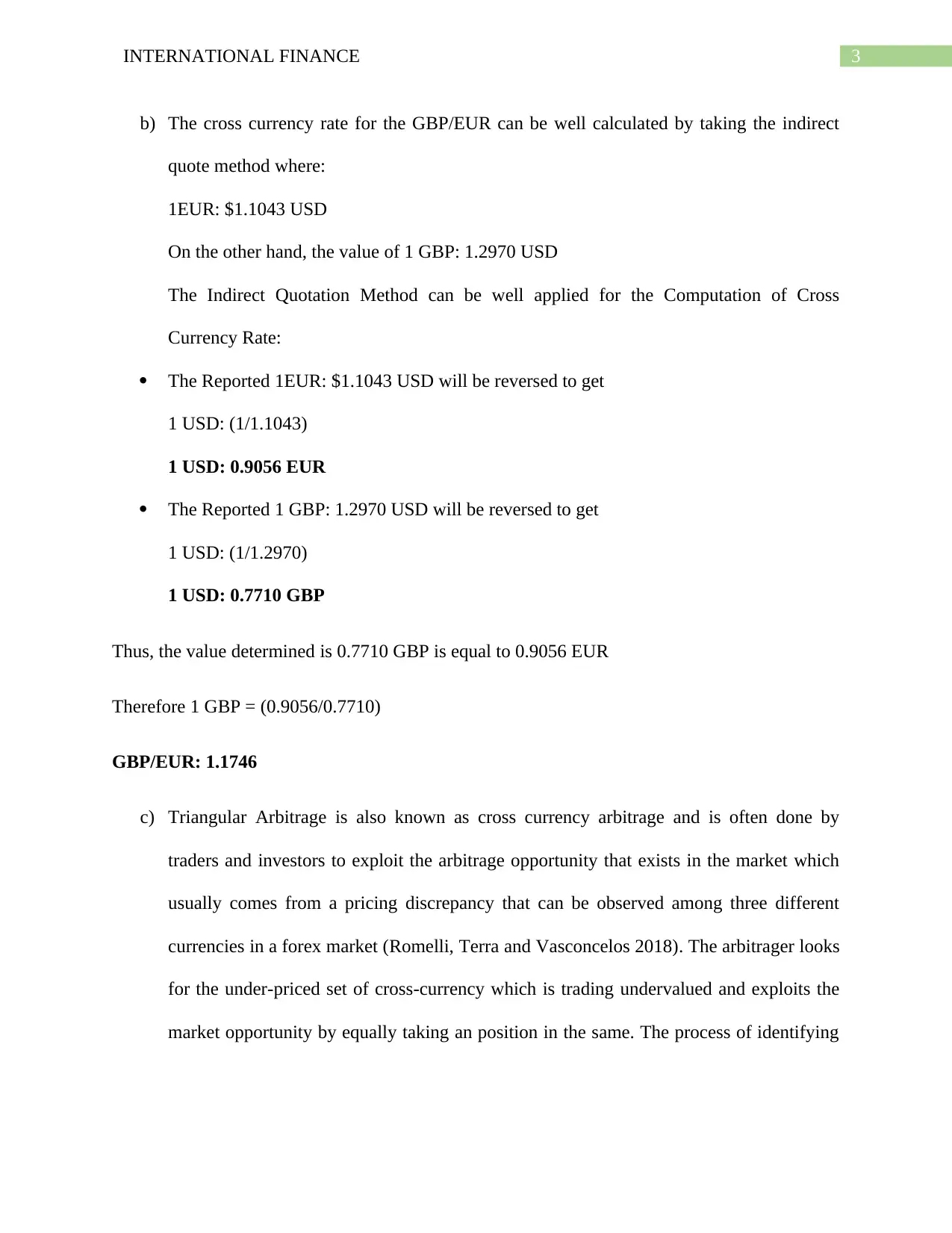
3INTERNATIONAL FINANCE
b) The cross currency rate for the GBP/EUR can be well calculated by taking the indirect
quote method where:
1EUR: $1.1043 USD
On the other hand, the value of 1 GBP: 1.2970 USD
The Indirect Quotation Method can be well applied for the Computation of Cross
Currency Rate:
The Reported 1EUR: $1.1043 USD will be reversed to get
1 USD: (1/1.1043)
1 USD: 0.9056 EUR
The Reported 1 GBP: 1.2970 USD will be reversed to get
1 USD: (1/1.2970)
1 USD: 0.7710 GBP
Thus, the value determined is 0.7710 GBP is equal to 0.9056 EUR
Therefore 1 GBP = (0.9056/0.7710)
GBP/EUR: 1.1746
c) Triangular Arbitrage is also known as cross currency arbitrage and is often done by
traders and investors to exploit the arbitrage opportunity that exists in the market which
usually comes from a pricing discrepancy that can be observed among three different
currencies in a forex market (Romelli, Terra and Vasconcelos 2018). The arbitrager looks
for the under-priced set of cross-currency which is trading undervalued and exploits the
market opportunity by equally taking an position in the same. The process of identifying
b) The cross currency rate for the GBP/EUR can be well calculated by taking the indirect
quote method where:
1EUR: $1.1043 USD
On the other hand, the value of 1 GBP: 1.2970 USD
The Indirect Quotation Method can be well applied for the Computation of Cross
Currency Rate:
The Reported 1EUR: $1.1043 USD will be reversed to get
1 USD: (1/1.1043)
1 USD: 0.9056 EUR
The Reported 1 GBP: 1.2970 USD will be reversed to get
1 USD: (1/1.2970)
1 USD: 0.7710 GBP
Thus, the value determined is 0.7710 GBP is equal to 0.9056 EUR
Therefore 1 GBP = (0.9056/0.7710)
GBP/EUR: 1.1746
c) Triangular Arbitrage is also known as cross currency arbitrage and is often done by
traders and investors to exploit the arbitrage opportunity that exists in the market which
usually comes from a pricing discrepancy that can be observed among three different
currencies in a forex market (Romelli, Terra and Vasconcelos 2018). The arbitrager looks
for the under-priced set of cross-currency which is trading undervalued and exploits the
market opportunity by equally taking an position in the same. The process of identifying
Secure Best Marks with AI Grader
Need help grading? Try our AI Grader for instant feedback on your assignments.
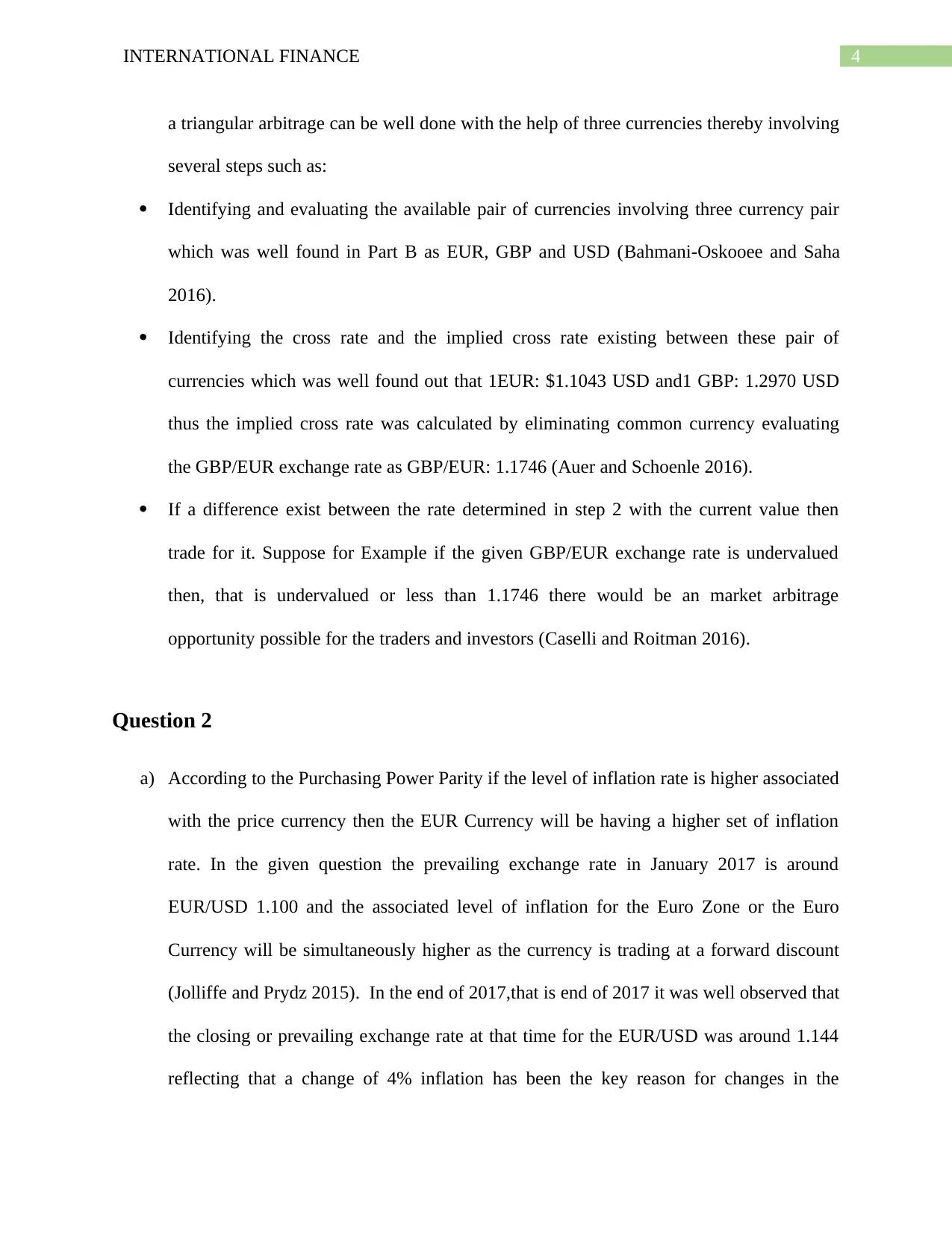
4INTERNATIONAL FINANCE
a triangular arbitrage can be well done with the help of three currencies thereby involving
several steps such as:
Identifying and evaluating the available pair of currencies involving three currency pair
which was well found in Part B as EUR, GBP and USD (Bahmani-Oskooee and Saha
2016).
Identifying the cross rate and the implied cross rate existing between these pair of
currencies which was well found out that 1EUR: $1.1043 USD and1 GBP: 1.2970 USD
thus the implied cross rate was calculated by eliminating common currency evaluating
the GBP/EUR exchange rate as GBP/EUR: 1.1746 (Auer and Schoenle 2016).
If a difference exist between the rate determined in step 2 with the current value then
trade for it. Suppose for Example if the given GBP/EUR exchange rate is undervalued
then, that is undervalued or less than 1.1746 there would be an market arbitrage
opportunity possible for the traders and investors (Caselli and Roitman 2016).
Question 2
a) According to the Purchasing Power Parity if the level of inflation rate is higher associated
with the price currency then the EUR Currency will be having a higher set of inflation
rate. In the given question the prevailing exchange rate in January 2017 is around
EUR/USD 1.100 and the associated level of inflation for the Euro Zone or the Euro
Currency will be simultaneously higher as the currency is trading at a forward discount
(Jolliffe and Prydz 2015). In the end of 2017,that is end of 2017 it was well observed that
the closing or prevailing exchange rate at that time for the EUR/USD was around 1.144
reflecting that a change of 4% inflation has been the key reason for changes in the
a triangular arbitrage can be well done with the help of three currencies thereby involving
several steps such as:
Identifying and evaluating the available pair of currencies involving three currency pair
which was well found in Part B as EUR, GBP and USD (Bahmani-Oskooee and Saha
2016).
Identifying the cross rate and the implied cross rate existing between these pair of
currencies which was well found out that 1EUR: $1.1043 USD and1 GBP: 1.2970 USD
thus the implied cross rate was calculated by eliminating common currency evaluating
the GBP/EUR exchange rate as GBP/EUR: 1.1746 (Auer and Schoenle 2016).
If a difference exist between the rate determined in step 2 with the current value then
trade for it. Suppose for Example if the given GBP/EUR exchange rate is undervalued
then, that is undervalued or less than 1.1746 there would be an market arbitrage
opportunity possible for the traders and investors (Caselli and Roitman 2016).
Question 2
a) According to the Purchasing Power Parity if the level of inflation rate is higher associated
with the price currency then the EUR Currency will be having a higher set of inflation
rate. In the given question the prevailing exchange rate in January 2017 is around
EUR/USD 1.100 and the associated level of inflation for the Euro Zone or the Euro
Currency will be simultaneously higher as the currency is trading at a forward discount
(Jolliffe and Prydz 2015). In the end of 2017,that is end of 2017 it was well observed that
the closing or prevailing exchange rate at that time for the EUR/USD was around 1.144
reflecting that a change of 4% inflation has been the key reason for changes in the
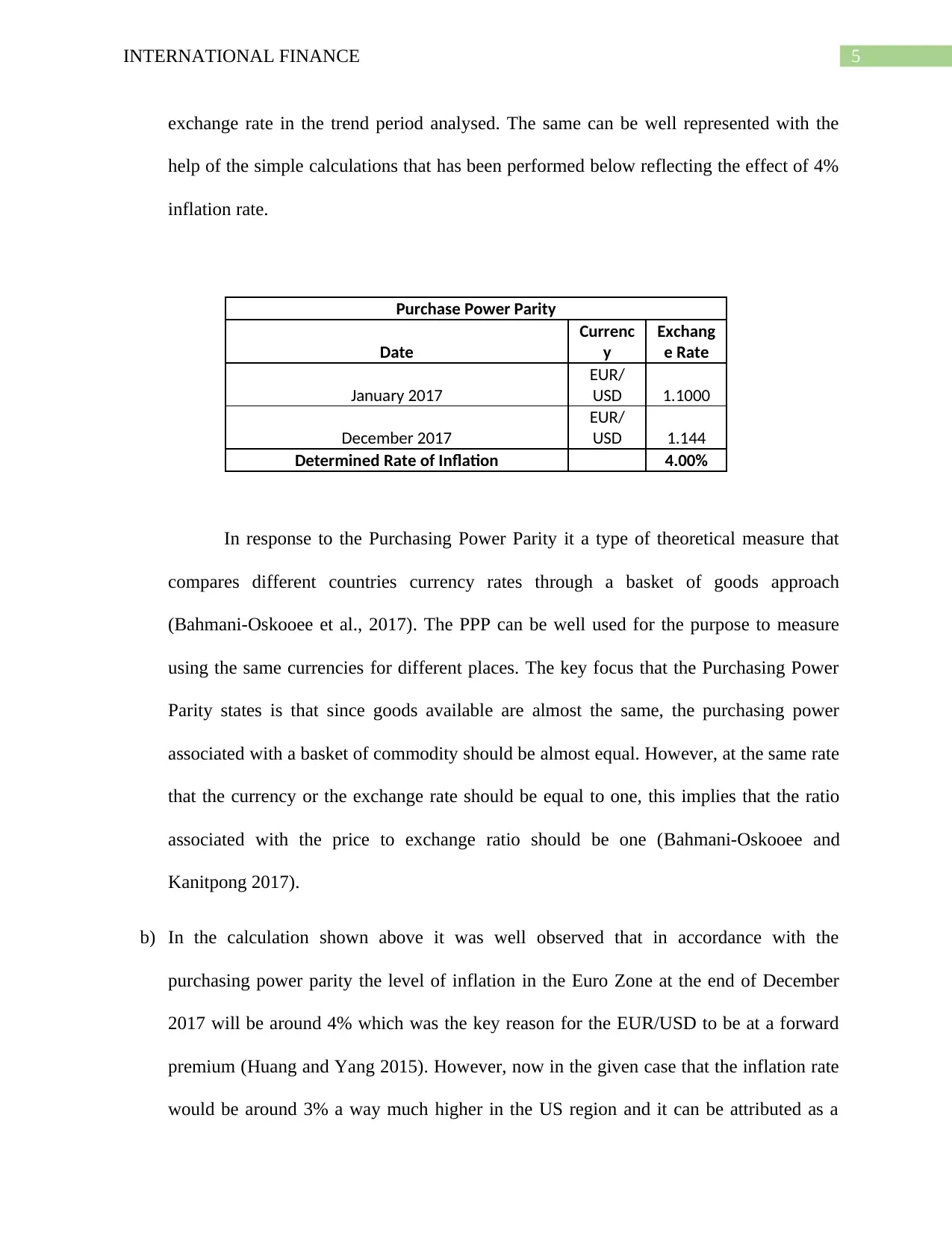
5INTERNATIONAL FINANCE
exchange rate in the trend period analysed. The same can be well represented with the
help of the simple calculations that has been performed below reflecting the effect of 4%
inflation rate.
Purchase Power Parity
Date
Currenc
y
Exchang
e Rate
January 2017
EUR/
USD 1.1000
December 2017
EUR/
USD 1.144
Determined Rate of Inflation 4.00%
In response to the Purchasing Power Parity it a type of theoretical measure that
compares different countries currency rates through a basket of goods approach
(Bahmani-Oskooee et al., 2017). The PPP can be well used for the purpose to measure
using the same currencies for different places. The key focus that the Purchasing Power
Parity states is that since goods available are almost the same, the purchasing power
associated with a basket of commodity should be almost equal. However, at the same rate
that the currency or the exchange rate should be equal to one, this implies that the ratio
associated with the price to exchange ratio should be one (Bahmani-Oskooee and
Kanitpong 2017).
b) In the calculation shown above it was well observed that in accordance with the
purchasing power parity the level of inflation in the Euro Zone at the end of December
2017 will be around 4% which was the key reason for the EUR/USD to be at a forward
premium (Huang and Yang 2015). However, now in the given case that the inflation rate
would be around 3% a way much higher in the US region and it can be attributed as a
exchange rate in the trend period analysed. The same can be well represented with the
help of the simple calculations that has been performed below reflecting the effect of 4%
inflation rate.
Purchase Power Parity
Date
Currenc
y
Exchang
e Rate
January 2017
EUR/
USD 1.1000
December 2017
EUR/
USD 1.144
Determined Rate of Inflation 4.00%
In response to the Purchasing Power Parity it a type of theoretical measure that
compares different countries currency rates through a basket of goods approach
(Bahmani-Oskooee et al., 2017). The PPP can be well used for the purpose to measure
using the same currencies for different places. The key focus that the Purchasing Power
Parity states is that since goods available are almost the same, the purchasing power
associated with a basket of commodity should be almost equal. However, at the same rate
that the currency or the exchange rate should be equal to one, this implies that the ratio
associated with the price to exchange ratio should be one (Bahmani-Oskooee and
Kanitpong 2017).
b) In the calculation shown above it was well observed that in accordance with the
purchasing power parity the level of inflation in the Euro Zone at the end of December
2017 will be around 4% which was the key reason for the EUR/USD to be at a forward
premium (Huang and Yang 2015). However, now in the given case that the inflation rate
would be around 3% a way much higher in the US region and it can be attributed as a
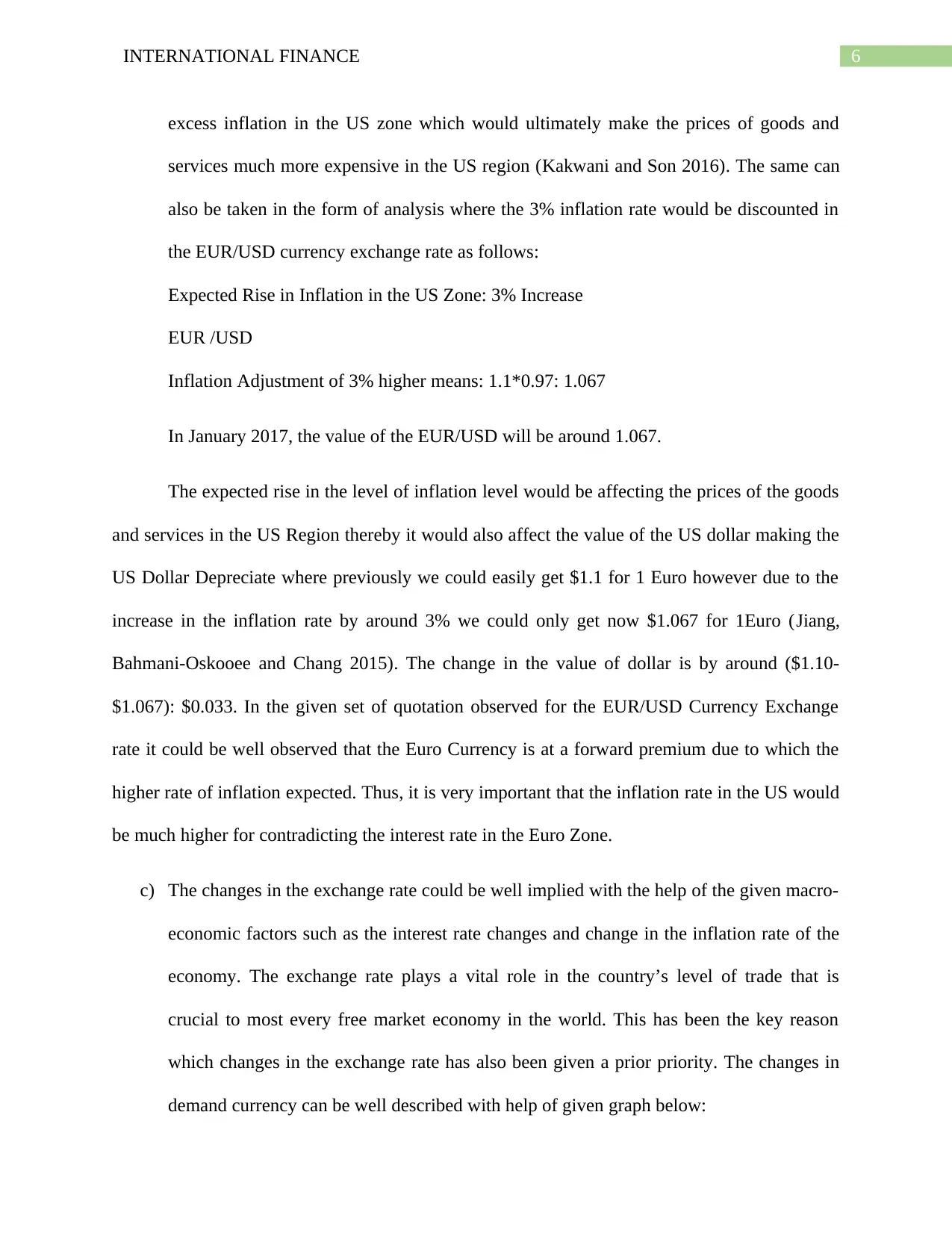
6INTERNATIONAL FINANCE
excess inflation in the US zone which would ultimately make the prices of goods and
services much more expensive in the US region (Kakwani and Son 2016). The same can
also be taken in the form of analysis where the 3% inflation rate would be discounted in
the EUR/USD currency exchange rate as follows:
Expected Rise in Inflation in the US Zone: 3% Increase
EUR /USD
Inflation Adjustment of 3% higher means: 1.1*0.97: 1.067
In January 2017, the value of the EUR/USD will be around 1.067.
The expected rise in the level of inflation level would be affecting the prices of the goods
and services in the US Region thereby it would also affect the value of the US dollar making the
US Dollar Depreciate where previously we could easily get $1.1 for 1 Euro however due to the
increase in the inflation rate by around 3% we could only get now $1.067 for 1Euro (Jiang,
Bahmani-Oskooee and Chang 2015). The change in the value of dollar is by around ($1.10-
$1.067): $0.033. In the given set of quotation observed for the EUR/USD Currency Exchange
rate it could be well observed that the Euro Currency is at a forward premium due to which the
higher rate of inflation expected. Thus, it is very important that the inflation rate in the US would
be much higher for contradicting the interest rate in the Euro Zone.
c) The changes in the exchange rate could be well implied with the help of the given macro-
economic factors such as the interest rate changes and change in the inflation rate of the
economy. The exchange rate plays a vital role in the country’s level of trade that is
crucial to most every free market economy in the world. This has been the key reason
which changes in the exchange rate has also been given a prior priority. The changes in
demand currency can be well described with help of given graph below:
excess inflation in the US zone which would ultimately make the prices of goods and
services much more expensive in the US region (Kakwani and Son 2016). The same can
also be taken in the form of analysis where the 3% inflation rate would be discounted in
the EUR/USD currency exchange rate as follows:
Expected Rise in Inflation in the US Zone: 3% Increase
EUR /USD
Inflation Adjustment of 3% higher means: 1.1*0.97: 1.067
In January 2017, the value of the EUR/USD will be around 1.067.
The expected rise in the level of inflation level would be affecting the prices of the goods
and services in the US Region thereby it would also affect the value of the US dollar making the
US Dollar Depreciate where previously we could easily get $1.1 for 1 Euro however due to the
increase in the inflation rate by around 3% we could only get now $1.067 for 1Euro (Jiang,
Bahmani-Oskooee and Chang 2015). The change in the value of dollar is by around ($1.10-
$1.067): $0.033. In the given set of quotation observed for the EUR/USD Currency Exchange
rate it could be well observed that the Euro Currency is at a forward premium due to which the
higher rate of inflation expected. Thus, it is very important that the inflation rate in the US would
be much higher for contradicting the interest rate in the Euro Zone.
c) The changes in the exchange rate could be well implied with the help of the given macro-
economic factors such as the interest rate changes and change in the inflation rate of the
economy. The exchange rate plays a vital role in the country’s level of trade that is
crucial to most every free market economy in the world. This has been the key reason
which changes in the exchange rate has also been given a prior priority. The changes in
demand currency can be well described with help of given graph below:
Paraphrase This Document
Need a fresh take? Get an instant paraphrase of this document with our AI Paraphraser
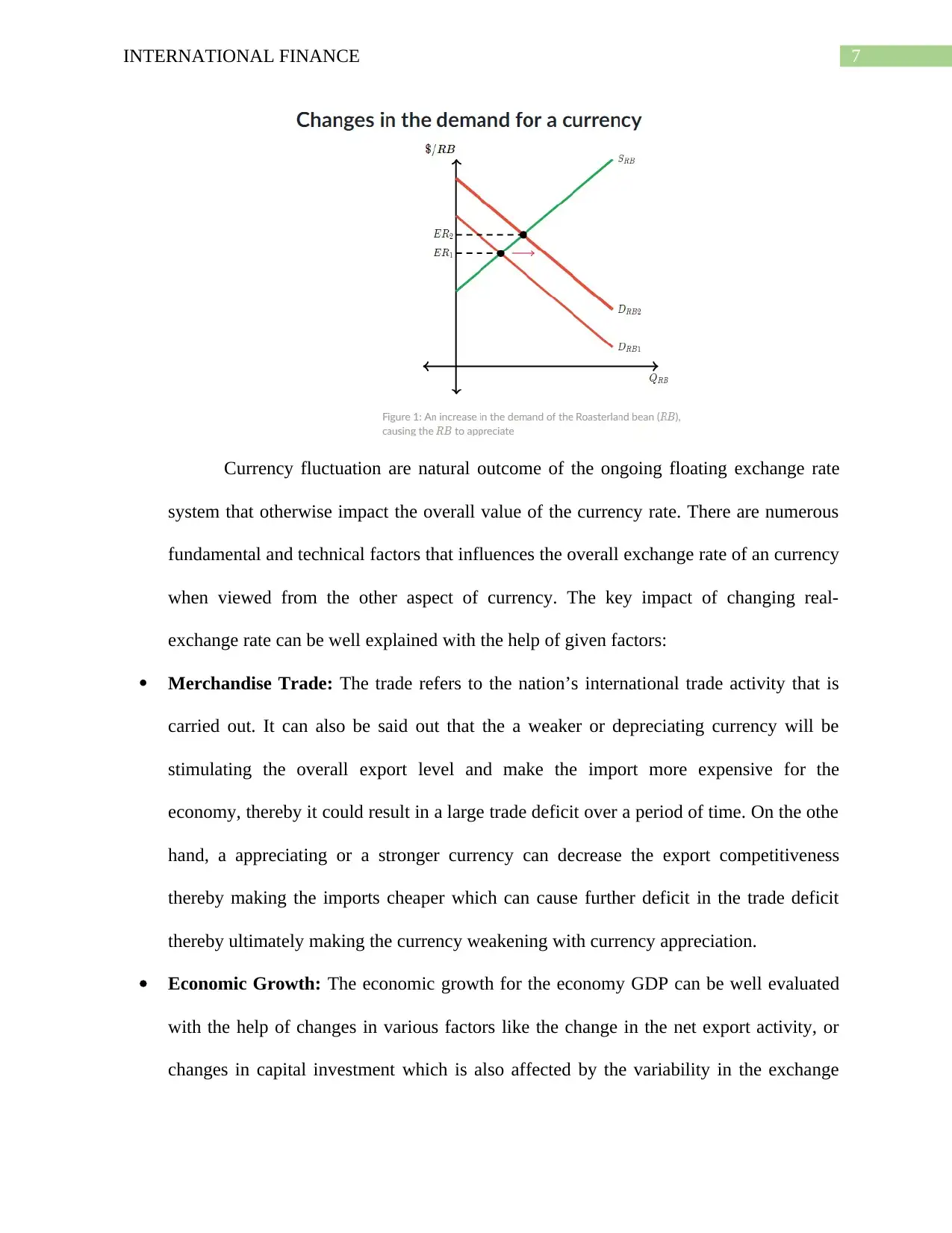
7INTERNATIONAL FINANCE
Currency fluctuation are natural outcome of the ongoing floating exchange rate
system that otherwise impact the overall value of the currency rate. There are numerous
fundamental and technical factors that influences the overall exchange rate of an currency
when viewed from the other aspect of currency. The key impact of changing real-
exchange rate can be well explained with the help of given factors:
Merchandise Trade: The trade refers to the nation’s international trade activity that is
carried out. It can also be said out that the a weaker or depreciating currency will be
stimulating the overall export level and make the import more expensive for the
economy, thereby it could result in a large trade deficit over a period of time. On the othe
hand, a appreciating or a stronger currency can decrease the export competitiveness
thereby making the imports cheaper which can cause further deficit in the trade deficit
thereby ultimately making the currency weakening with currency appreciation.
Economic Growth: The economic growth for the economy GDP can be well evaluated
with the help of changes in various factors like the change in the net export activity, or
changes in capital investment which is also affected by the variability in the exchange
Currency fluctuation are natural outcome of the ongoing floating exchange rate
system that otherwise impact the overall value of the currency rate. There are numerous
fundamental and technical factors that influences the overall exchange rate of an currency
when viewed from the other aspect of currency. The key impact of changing real-
exchange rate can be well explained with the help of given factors:
Merchandise Trade: The trade refers to the nation’s international trade activity that is
carried out. It can also be said out that the a weaker or depreciating currency will be
stimulating the overall export level and make the import more expensive for the
economy, thereby it could result in a large trade deficit over a period of time. On the othe
hand, a appreciating or a stronger currency can decrease the export competitiveness
thereby making the imports cheaper which can cause further deficit in the trade deficit
thereby ultimately making the currency weakening with currency appreciation.
Economic Growth: The economic growth for the economy GDP can be well evaluated
with the help of changes in various factors like the change in the net export activity, or
changes in capital investment which is also affected by the variability in the exchange
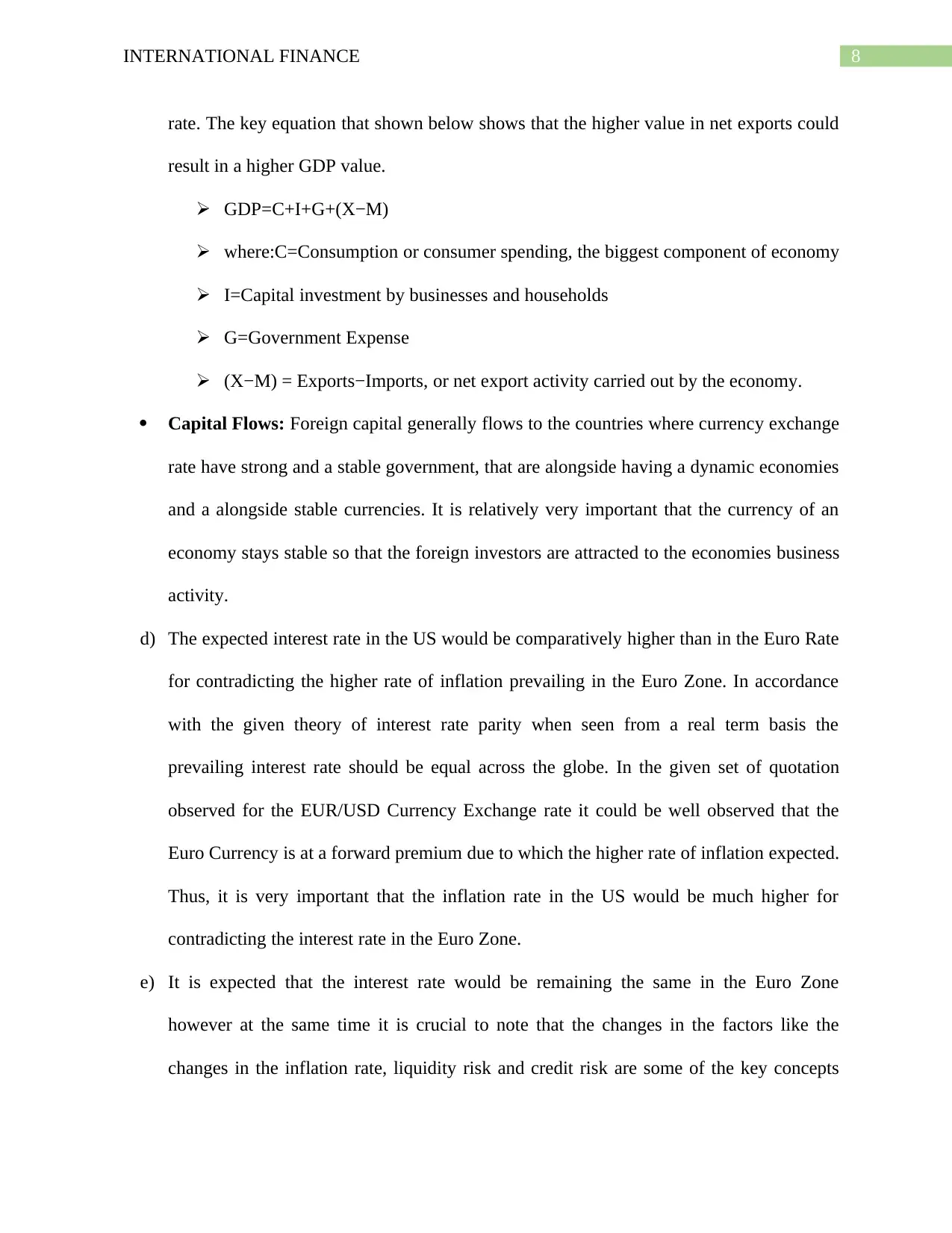
8INTERNATIONAL FINANCE
rate. The key equation that shown below shows that the higher value in net exports could
result in a higher GDP value.
GDP=C+I+G+(X−M)
where:C=Consumption or consumer spending, the biggest component of economy
I=Capital investment by businesses and households
G=Government Expense
(X−M) = Exports−Imports, or net export activity carried out by the economy.
Capital Flows: Foreign capital generally flows to the countries where currency exchange
rate have strong and a stable government, that are alongside having a dynamic economies
and a alongside stable currencies. It is relatively very important that the currency of an
economy stays stable so that the foreign investors are attracted to the economies business
activity.
d) The expected interest rate in the US would be comparatively higher than in the Euro Rate
for contradicting the higher rate of inflation prevailing in the Euro Zone. In accordance
with the given theory of interest rate parity when seen from a real term basis the
prevailing interest rate should be equal across the globe. In the given set of quotation
observed for the EUR/USD Currency Exchange rate it could be well observed that the
Euro Currency is at a forward premium due to which the higher rate of inflation expected.
Thus, it is very important that the inflation rate in the US would be much higher for
contradicting the interest rate in the Euro Zone.
e) It is expected that the interest rate would be remaining the same in the Euro Zone
however at the same time it is crucial to note that the changes in the factors like the
changes in the inflation rate, liquidity risk and credit risk are some of the key concepts
rate. The key equation that shown below shows that the higher value in net exports could
result in a higher GDP value.
GDP=C+I+G+(X−M)
where:C=Consumption or consumer spending, the biggest component of economy
I=Capital investment by businesses and households
G=Government Expense
(X−M) = Exports−Imports, or net export activity carried out by the economy.
Capital Flows: Foreign capital generally flows to the countries where currency exchange
rate have strong and a stable government, that are alongside having a dynamic economies
and a alongside stable currencies. It is relatively very important that the currency of an
economy stays stable so that the foreign investors are attracted to the economies business
activity.
d) The expected interest rate in the US would be comparatively higher than in the Euro Rate
for contradicting the higher rate of inflation prevailing in the Euro Zone. In accordance
with the given theory of interest rate parity when seen from a real term basis the
prevailing interest rate should be equal across the globe. In the given set of quotation
observed for the EUR/USD Currency Exchange rate it could be well observed that the
Euro Currency is at a forward premium due to which the higher rate of inflation expected.
Thus, it is very important that the inflation rate in the US would be much higher for
contradicting the interest rate in the Euro Zone.
e) It is expected that the interest rate would be remaining the same in the Euro Zone
however at the same time it is crucial to note that the changes in the factors like the
changes in the inflation rate, liquidity risk and credit risk are some of the key concepts
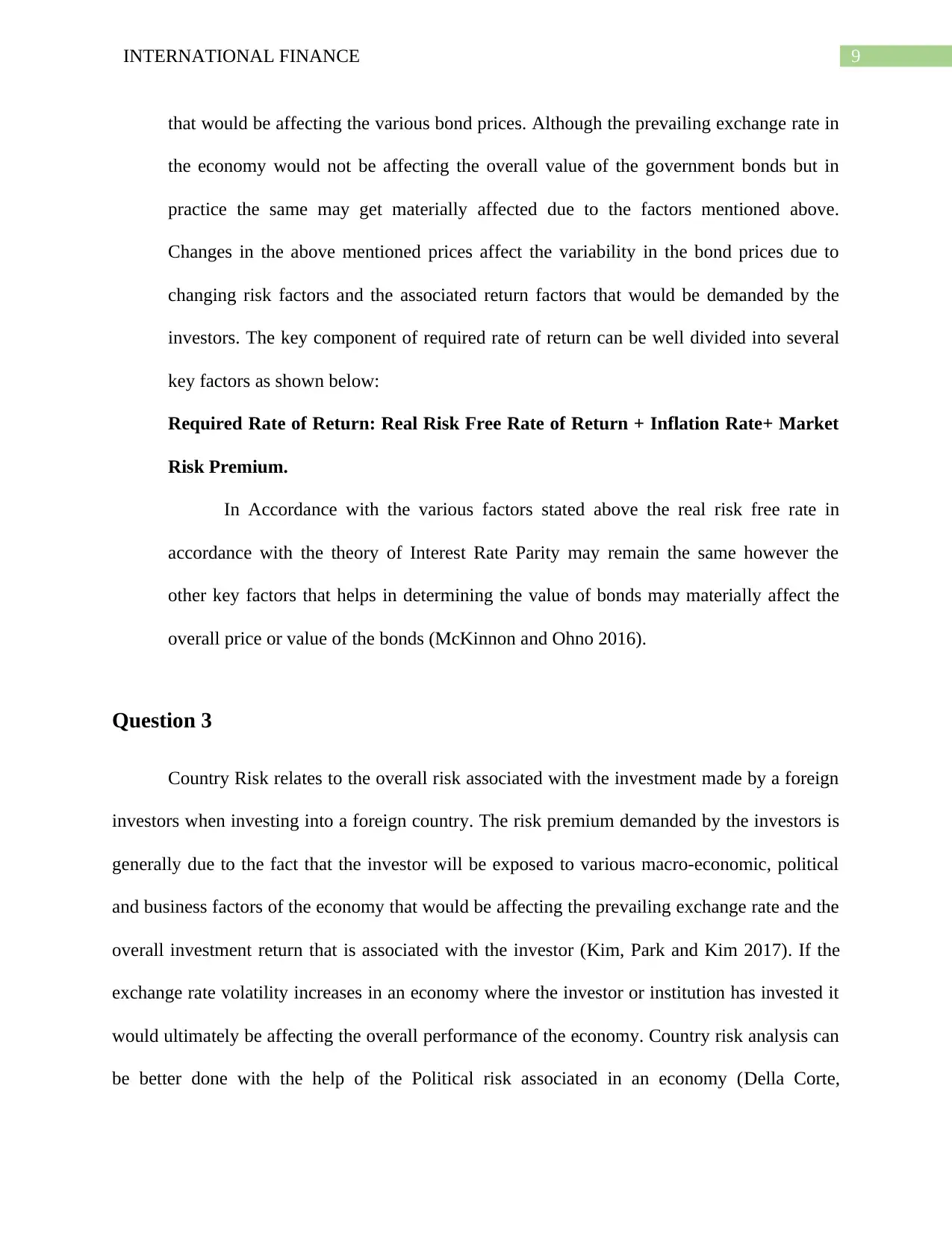
9INTERNATIONAL FINANCE
that would be affecting the various bond prices. Although the prevailing exchange rate in
the economy would not be affecting the overall value of the government bonds but in
practice the same may get materially affected due to the factors mentioned above.
Changes in the above mentioned prices affect the variability in the bond prices due to
changing risk factors and the associated return factors that would be demanded by the
investors. The key component of required rate of return can be well divided into several
key factors as shown below:
Required Rate of Return: Real Risk Free Rate of Return + Inflation Rate+ Market
Risk Premium.
In Accordance with the various factors stated above the real risk free rate in
accordance with the theory of Interest Rate Parity may remain the same however the
other key factors that helps in determining the value of bonds may materially affect the
overall price or value of the bonds (McKinnon and Ohno 2016).
Question 3
Country Risk relates to the overall risk associated with the investment made by a foreign
investors when investing into a foreign country. The risk premium demanded by the investors is
generally due to the fact that the investor will be exposed to various macro-economic, political
and business factors of the economy that would be affecting the prevailing exchange rate and the
overall investment return that is associated with the investor (Kim, Park and Kim 2017). If the
exchange rate volatility increases in an economy where the investor or institution has invested it
would ultimately be affecting the overall performance of the economy. Country risk analysis can
be better done with the help of the Political risk associated in an economy (Della Corte,
that would be affecting the various bond prices. Although the prevailing exchange rate in
the economy would not be affecting the overall value of the government bonds but in
practice the same may get materially affected due to the factors mentioned above.
Changes in the above mentioned prices affect the variability in the bond prices due to
changing risk factors and the associated return factors that would be demanded by the
investors. The key component of required rate of return can be well divided into several
key factors as shown below:
Required Rate of Return: Real Risk Free Rate of Return + Inflation Rate+ Market
Risk Premium.
In Accordance with the various factors stated above the real risk free rate in
accordance with the theory of Interest Rate Parity may remain the same however the
other key factors that helps in determining the value of bonds may materially affect the
overall price or value of the bonds (McKinnon and Ohno 2016).
Question 3
Country Risk relates to the overall risk associated with the investment made by a foreign
investors when investing into a foreign country. The risk premium demanded by the investors is
generally due to the fact that the investor will be exposed to various macro-economic, political
and business factors of the economy that would be affecting the prevailing exchange rate and the
overall investment return that is associated with the investor (Kim, Park and Kim 2017). If the
exchange rate volatility increases in an economy where the investor or institution has invested it
would ultimately be affecting the overall performance of the economy. Country risk analysis can
be better done with the help of the Political risk associated in an economy (Della Corte,
Secure Best Marks with AI Grader
Need help grading? Try our AI Grader for instant feedback on your assignments.
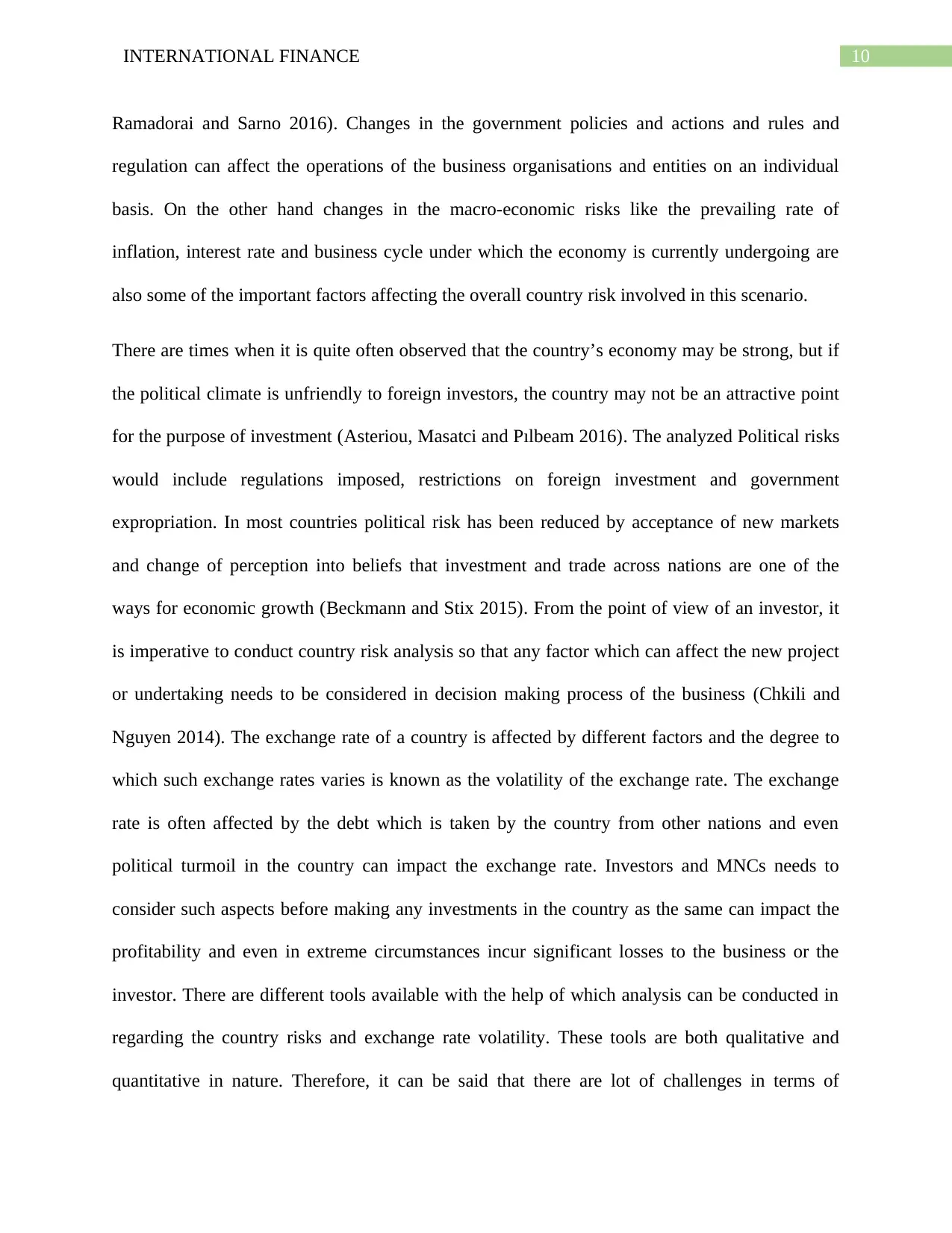
10INTERNATIONAL FINANCE
Ramadorai and Sarno 2016). Changes in the government policies and actions and rules and
regulation can affect the operations of the business organisations and entities on an individual
basis. On the other hand changes in the macro-economic risks like the prevailing rate of
inflation, interest rate and business cycle under which the economy is currently undergoing are
also some of the important factors affecting the overall country risk involved in this scenario.
There are times when it is quite often observed that the country’s economy may be strong, but if
the political climate is unfriendly to foreign investors, the country may not be an attractive point
for the purpose of investment (Asteriou, Masatci and Pılbeam 2016). The analyzed Political risks
would include regulations imposed, restrictions on foreign investment and government
expropriation. In most countries political risk has been reduced by acceptance of new markets
and change of perception into beliefs that investment and trade across nations are one of the
ways for economic growth (Beckmann and Stix 2015). From the point of view of an investor, it
is imperative to conduct country risk analysis so that any factor which can affect the new project
or undertaking needs to be considered in decision making process of the business (Chkili and
Nguyen 2014). The exchange rate of a country is affected by different factors and the degree to
which such exchange rates varies is known as the volatility of the exchange rate. The exchange
rate is often affected by the debt which is taken by the country from other nations and even
political turmoil in the country can impact the exchange rate. Investors and MNCs needs to
consider such aspects before making any investments in the country as the same can impact the
profitability and even in extreme circumstances incur significant losses to the business or the
investor. There are different tools available with the help of which analysis can be conducted in
regarding the country risks and exchange rate volatility. These tools are both qualitative and
quantitative in nature. Therefore, it can be said that there are lot of challenges in terms of
Ramadorai and Sarno 2016). Changes in the government policies and actions and rules and
regulation can affect the operations of the business organisations and entities on an individual
basis. On the other hand changes in the macro-economic risks like the prevailing rate of
inflation, interest rate and business cycle under which the economy is currently undergoing are
also some of the important factors affecting the overall country risk involved in this scenario.
There are times when it is quite often observed that the country’s economy may be strong, but if
the political climate is unfriendly to foreign investors, the country may not be an attractive point
for the purpose of investment (Asteriou, Masatci and Pılbeam 2016). The analyzed Political risks
would include regulations imposed, restrictions on foreign investment and government
expropriation. In most countries political risk has been reduced by acceptance of new markets
and change of perception into beliefs that investment and trade across nations are one of the
ways for economic growth (Beckmann and Stix 2015). From the point of view of an investor, it
is imperative to conduct country risk analysis so that any factor which can affect the new project
or undertaking needs to be considered in decision making process of the business (Chkili and
Nguyen 2014). The exchange rate of a country is affected by different factors and the degree to
which such exchange rates varies is known as the volatility of the exchange rate. The exchange
rate is often affected by the debt which is taken by the country from other nations and even
political turmoil in the country can impact the exchange rate. Investors and MNCs needs to
consider such aspects before making any investments in the country as the same can impact the
profitability and even in extreme circumstances incur significant losses to the business or the
investor. There are different tools available with the help of which analysis can be conducted in
regarding the country risks and exchange rate volatility. These tools are both qualitative and
quantitative in nature. Therefore, it can be said that there are lot of challenges in terms of
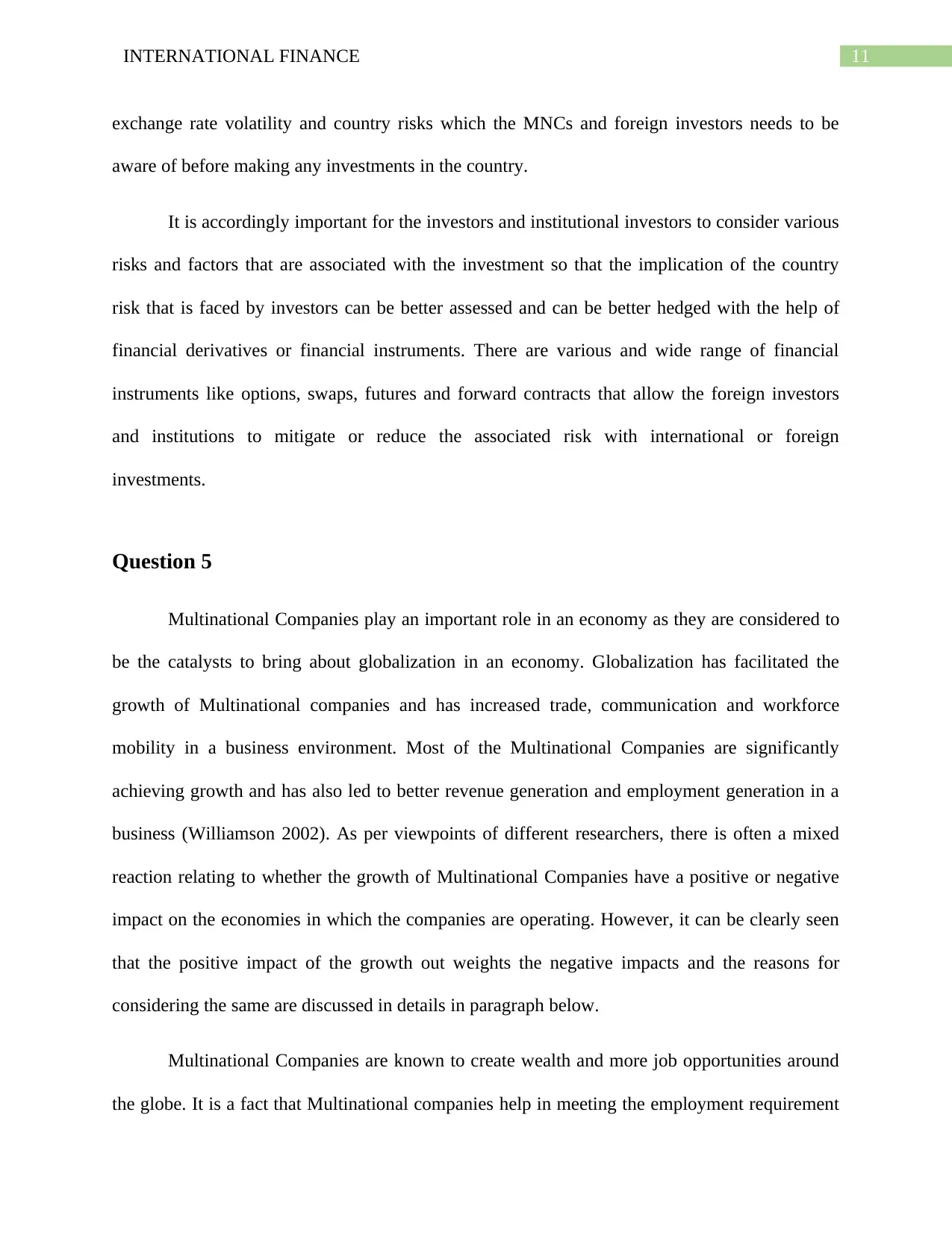
11INTERNATIONAL FINANCE
exchange rate volatility and country risks which the MNCs and foreign investors needs to be
aware of before making any investments in the country.
It is accordingly important for the investors and institutional investors to consider various
risks and factors that are associated with the investment so that the implication of the country
risk that is faced by investors can be better assessed and can be better hedged with the help of
financial derivatives or financial instruments. There are various and wide range of financial
instruments like options, swaps, futures and forward contracts that allow the foreign investors
and institutions to mitigate or reduce the associated risk with international or foreign
investments.
Question 5
Multinational Companies play an important role in an economy as they are considered to
be the catalysts to bring about globalization in an economy. Globalization has facilitated the
growth of Multinational companies and has increased trade, communication and workforce
mobility in a business environment. Most of the Multinational Companies are significantly
achieving growth and has also led to better revenue generation and employment generation in a
business (Williamson 2002). As per viewpoints of different researchers, there is often a mixed
reaction relating to whether the growth of Multinational Companies have a positive or negative
impact on the economies in which the companies are operating. However, it can be clearly seen
that the positive impact of the growth out weights the negative impacts and the reasons for
considering the same are discussed in details in paragraph below.
Multinational Companies are known to create wealth and more job opportunities around
the globe. It is a fact that Multinational companies help in meeting the employment requirement
exchange rate volatility and country risks which the MNCs and foreign investors needs to be
aware of before making any investments in the country.
It is accordingly important for the investors and institutional investors to consider various
risks and factors that are associated with the investment so that the implication of the country
risk that is faced by investors can be better assessed and can be better hedged with the help of
financial derivatives or financial instruments. There are various and wide range of financial
instruments like options, swaps, futures and forward contracts that allow the foreign investors
and institutions to mitigate or reduce the associated risk with international or foreign
investments.
Question 5
Multinational Companies play an important role in an economy as they are considered to
be the catalysts to bring about globalization in an economy. Globalization has facilitated the
growth of Multinational companies and has increased trade, communication and workforce
mobility in a business environment. Most of the Multinational Companies are significantly
achieving growth and has also led to better revenue generation and employment generation in a
business (Williamson 2002). As per viewpoints of different researchers, there is often a mixed
reaction relating to whether the growth of Multinational Companies have a positive or negative
impact on the economies in which the companies are operating. However, it can be clearly seen
that the positive impact of the growth out weights the negative impacts and the reasons for
considering the same are discussed in details in paragraph below.
Multinational Companies are known to create wealth and more job opportunities around
the globe. It is a fact that Multinational companies help in meeting the employment requirement
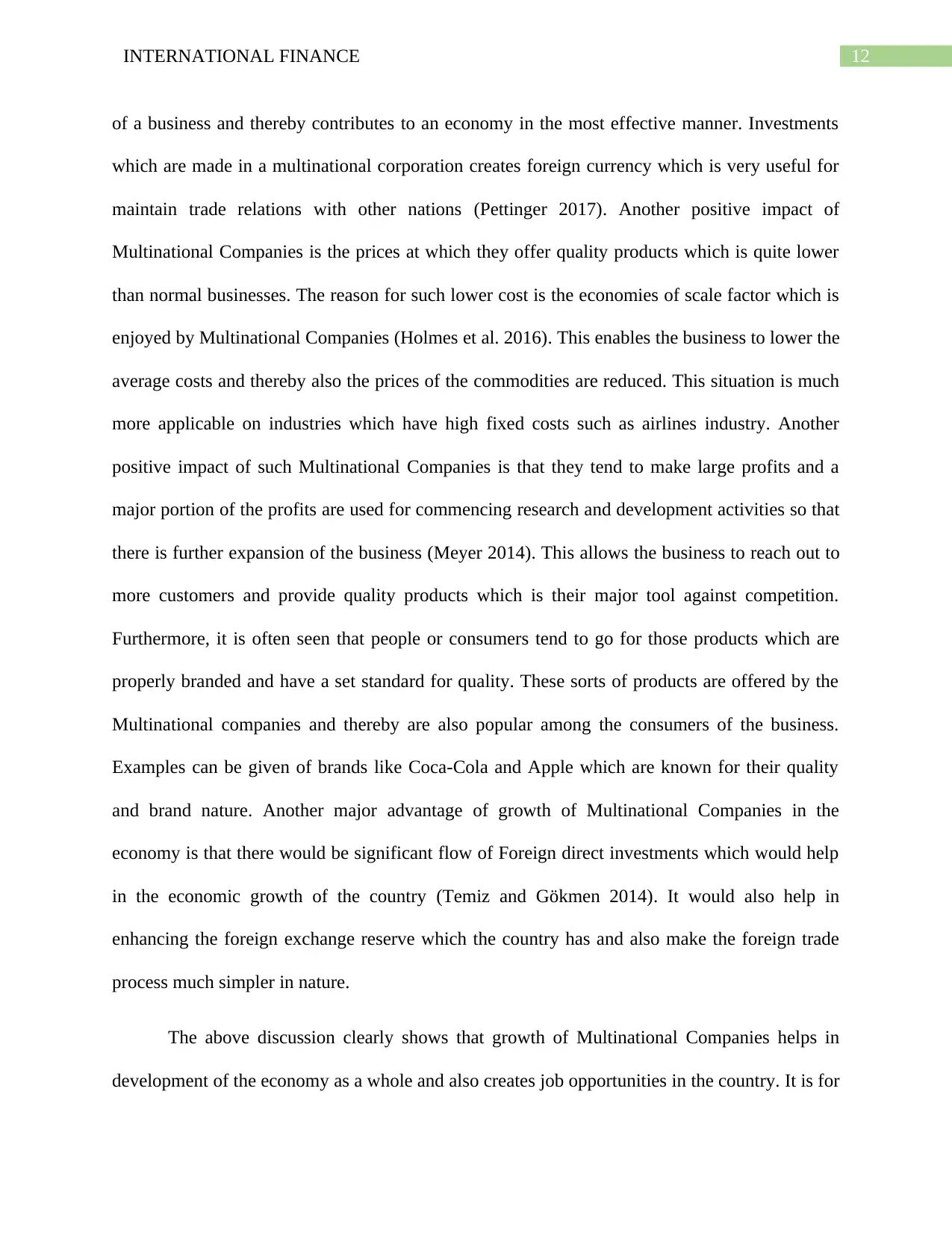
12INTERNATIONAL FINANCE
of a business and thereby contributes to an economy in the most effective manner. Investments
which are made in a multinational corporation creates foreign currency which is very useful for
maintain trade relations with other nations (Pettinger 2017). Another positive impact of
Multinational Companies is the prices at which they offer quality products which is quite lower
than normal businesses. The reason for such lower cost is the economies of scale factor which is
enjoyed by Multinational Companies (Holmes et al. 2016). This enables the business to lower the
average costs and thereby also the prices of the commodities are reduced. This situation is much
more applicable on industries which have high fixed costs such as airlines industry. Another
positive impact of such Multinational Companies is that they tend to make large profits and a
major portion of the profits are used for commencing research and development activities so that
there is further expansion of the business (Meyer 2014). This allows the business to reach out to
more customers and provide quality products which is their major tool against competition.
Furthermore, it is often seen that people or consumers tend to go for those products which are
properly branded and have a set standard for quality. These sorts of products are offered by the
Multinational companies and thereby are also popular among the consumers of the business.
Examples can be given of brands like Coca-Cola and Apple which are known for their quality
and brand nature. Another major advantage of growth of Multinational Companies in the
economy is that there would be significant flow of Foreign direct investments which would help
in the economic growth of the country (Temiz and Gökmen 2014). It would also help in
enhancing the foreign exchange reserve which the country has and also make the foreign trade
process much simpler in nature.
The above discussion clearly shows that growth of Multinational Companies helps in
development of the economy as a whole and also creates job opportunities in the country. It is for
of a business and thereby contributes to an economy in the most effective manner. Investments
which are made in a multinational corporation creates foreign currency which is very useful for
maintain trade relations with other nations (Pettinger 2017). Another positive impact of
Multinational Companies is the prices at which they offer quality products which is quite lower
than normal businesses. The reason for such lower cost is the economies of scale factor which is
enjoyed by Multinational Companies (Holmes et al. 2016). This enables the business to lower the
average costs and thereby also the prices of the commodities are reduced. This situation is much
more applicable on industries which have high fixed costs such as airlines industry. Another
positive impact of such Multinational Companies is that they tend to make large profits and a
major portion of the profits are used for commencing research and development activities so that
there is further expansion of the business (Meyer 2014). This allows the business to reach out to
more customers and provide quality products which is their major tool against competition.
Furthermore, it is often seen that people or consumers tend to go for those products which are
properly branded and have a set standard for quality. These sorts of products are offered by the
Multinational companies and thereby are also popular among the consumers of the business.
Examples can be given of brands like Coca-Cola and Apple which are known for their quality
and brand nature. Another major advantage of growth of Multinational Companies in the
economy is that there would be significant flow of Foreign direct investments which would help
in the economic growth of the country (Temiz and Gökmen 2014). It would also help in
enhancing the foreign exchange reserve which the country has and also make the foreign trade
process much simpler in nature.
The above discussion clearly shows that growth of Multinational Companies helps in
development of the economy as a whole and also creates job opportunities in the country. It is for
Paraphrase This Document
Need a fresh take? Get an instant paraphrase of this document with our AI Paraphraser
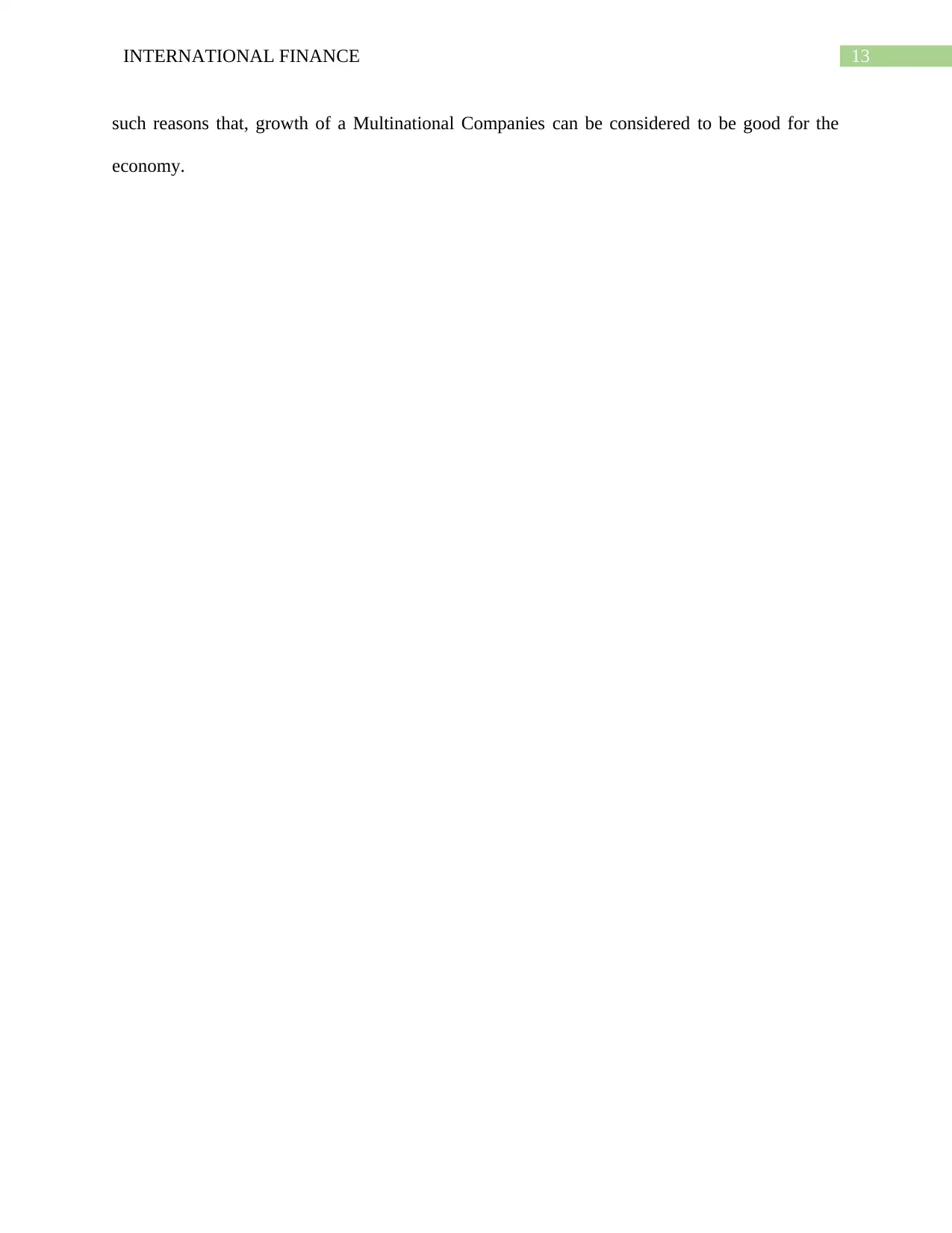
13INTERNATIONAL FINANCE
such reasons that, growth of a Multinational Companies can be considered to be good for the
economy.
such reasons that, growth of a Multinational Companies can be considered to be good for the
economy.
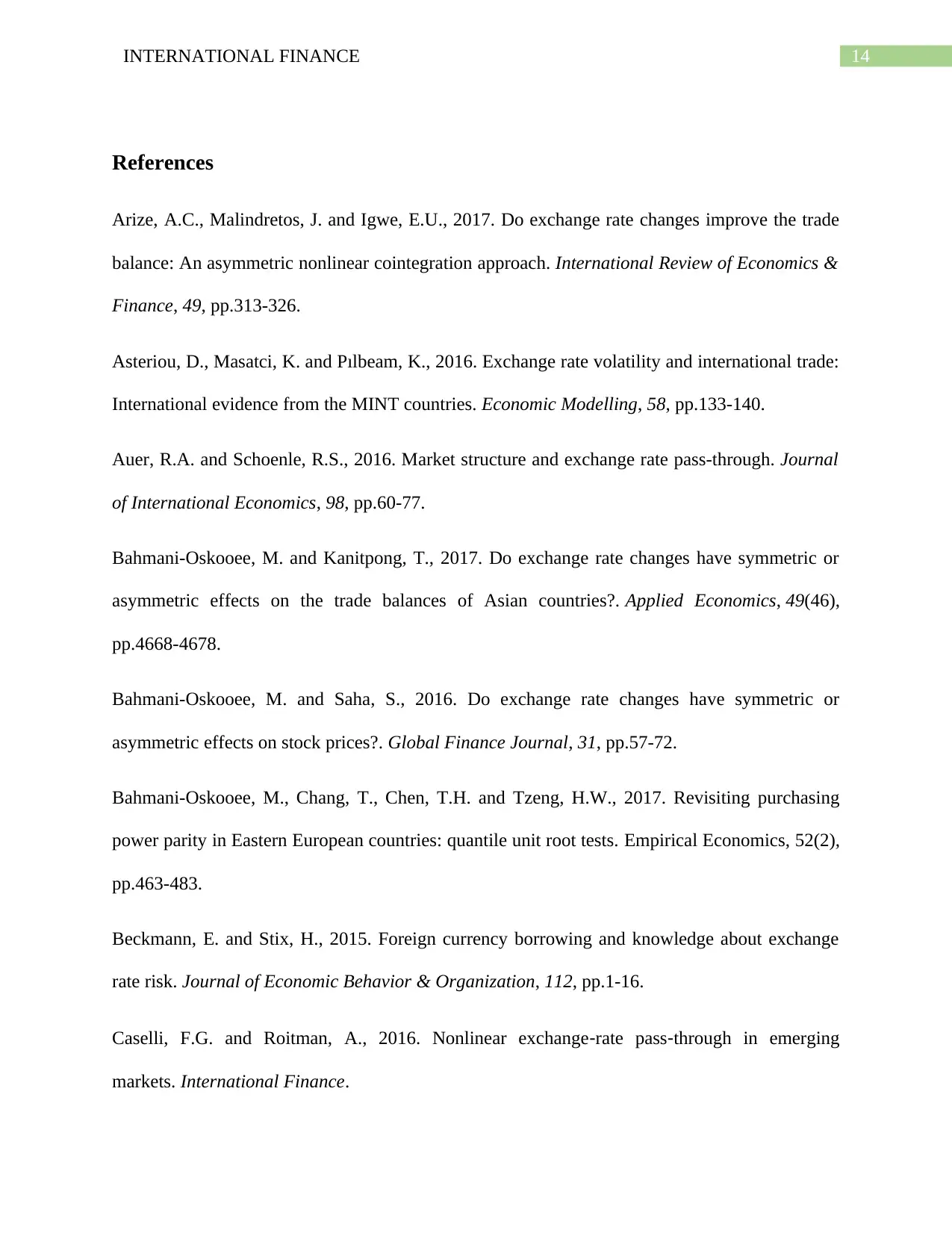
14INTERNATIONAL FINANCE
References
Arize, A.C., Malindretos, J. and Igwe, E.U., 2017. Do exchange rate changes improve the trade
balance: An asymmetric nonlinear cointegration approach. International Review of Economics &
Finance, 49, pp.313-326.
Asteriou, D., Masatci, K. and Pılbeam, K., 2016. Exchange rate volatility and international trade:
International evidence from the MINT countries. Economic Modelling, 58, pp.133-140.
Auer, R.A. and Schoenle, R.S., 2016. Market structure and exchange rate pass-through. Journal
of International Economics, 98, pp.60-77.
Bahmani-Oskooee, M. and Kanitpong, T., 2017. Do exchange rate changes have symmetric or
asymmetric effects on the trade balances of Asian countries?. Applied Economics, 49(46),
pp.4668-4678.
Bahmani-Oskooee, M. and Saha, S., 2016. Do exchange rate changes have symmetric or
asymmetric effects on stock prices?. Global Finance Journal, 31, pp.57-72.
Bahmani-Oskooee, M., Chang, T., Chen, T.H. and Tzeng, H.W., 2017. Revisiting purchasing
power parity in Eastern European countries: quantile unit root tests. Empirical Economics, 52(2),
pp.463-483.
Beckmann, E. and Stix, H., 2015. Foreign currency borrowing and knowledge about exchange
rate risk. Journal of Economic Behavior & Organization, 112, pp.1-16.
Caselli, F.G. and Roitman, A., 2016. Nonlinear exchange‐rate pass‐through in emerging
markets. International Finance.
References
Arize, A.C., Malindretos, J. and Igwe, E.U., 2017. Do exchange rate changes improve the trade
balance: An asymmetric nonlinear cointegration approach. International Review of Economics &
Finance, 49, pp.313-326.
Asteriou, D., Masatci, K. and Pılbeam, K., 2016. Exchange rate volatility and international trade:
International evidence from the MINT countries. Economic Modelling, 58, pp.133-140.
Auer, R.A. and Schoenle, R.S., 2016. Market structure and exchange rate pass-through. Journal
of International Economics, 98, pp.60-77.
Bahmani-Oskooee, M. and Kanitpong, T., 2017. Do exchange rate changes have symmetric or
asymmetric effects on the trade balances of Asian countries?. Applied Economics, 49(46),
pp.4668-4678.
Bahmani-Oskooee, M. and Saha, S., 2016. Do exchange rate changes have symmetric or
asymmetric effects on stock prices?. Global Finance Journal, 31, pp.57-72.
Bahmani-Oskooee, M., Chang, T., Chen, T.H. and Tzeng, H.W., 2017. Revisiting purchasing
power parity in Eastern European countries: quantile unit root tests. Empirical Economics, 52(2),
pp.463-483.
Beckmann, E. and Stix, H., 2015. Foreign currency borrowing and knowledge about exchange
rate risk. Journal of Economic Behavior & Organization, 112, pp.1-16.
Caselli, F.G. and Roitman, A., 2016. Nonlinear exchange‐rate pass‐through in emerging
markets. International Finance.
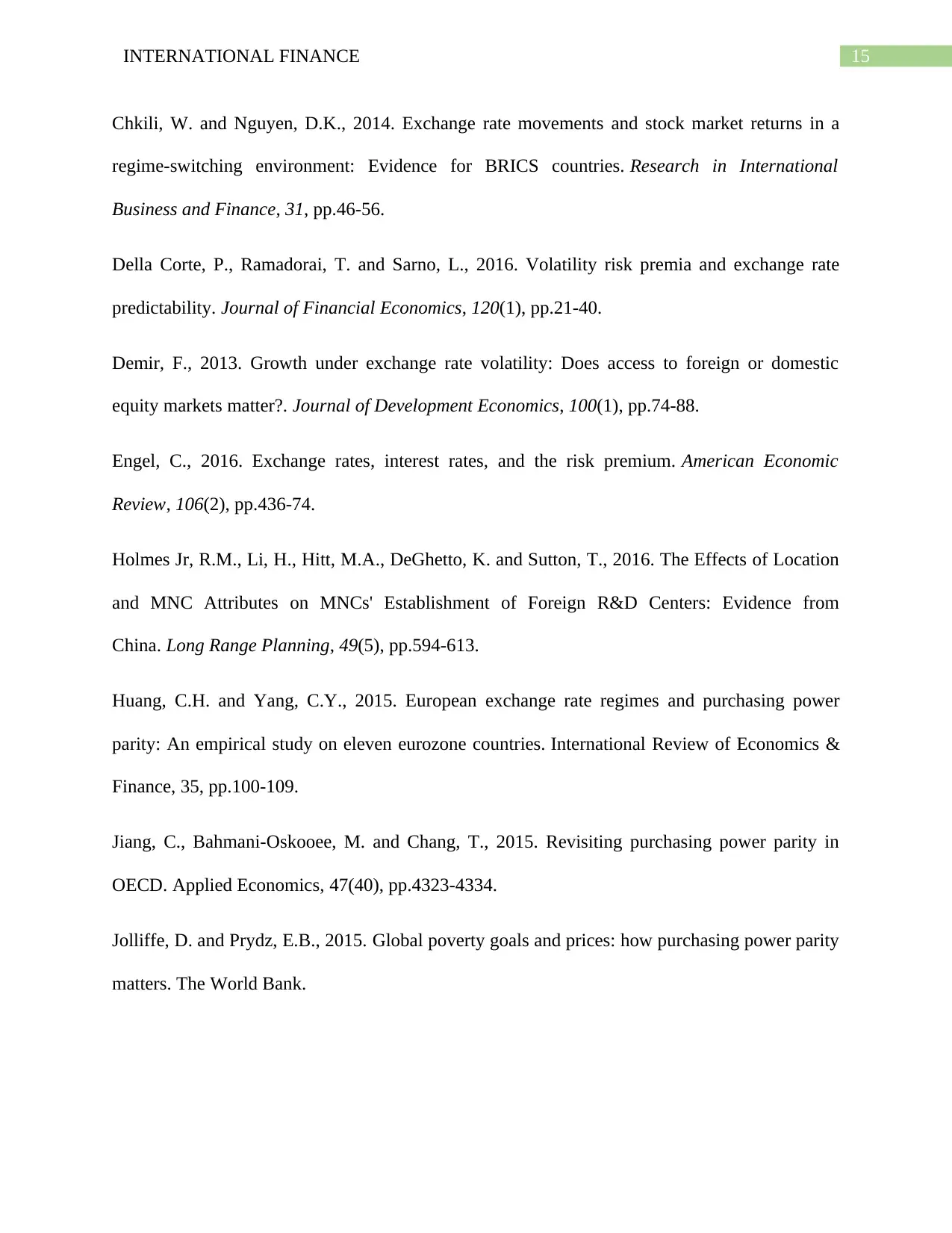
15INTERNATIONAL FINANCE
Chkili, W. and Nguyen, D.K., 2014. Exchange rate movements and stock market returns in a
regime-switching environment: Evidence for BRICS countries. Research in International
Business and Finance, 31, pp.46-56.
Della Corte, P., Ramadorai, T. and Sarno, L., 2016. Volatility risk premia and exchange rate
predictability. Journal of Financial Economics, 120(1), pp.21-40.
Demir, F., 2013. Growth under exchange rate volatility: Does access to foreign or domestic
equity markets matter?. Journal of Development Economics, 100(1), pp.74-88.
Engel, C., 2016. Exchange rates, interest rates, and the risk premium. American Economic
Review, 106(2), pp.436-74.
Holmes Jr, R.M., Li, H., Hitt, M.A., DeGhetto, K. and Sutton, T., 2016. The Effects of Location
and MNC Attributes on MNCs' Establishment of Foreign R&D Centers: Evidence from
China. Long Range Planning, 49(5), pp.594-613.
Huang, C.H. and Yang, C.Y., 2015. European exchange rate regimes and purchasing power
parity: An empirical study on eleven eurozone countries. International Review of Economics &
Finance, 35, pp.100-109.
Jiang, C., Bahmani-Oskooee, M. and Chang, T., 2015. Revisiting purchasing power parity in
OECD. Applied Economics, 47(40), pp.4323-4334.
Jolliffe, D. and Prydz, E.B., 2015. Global poverty goals and prices: how purchasing power parity
matters. The World Bank.
Chkili, W. and Nguyen, D.K., 2014. Exchange rate movements and stock market returns in a
regime-switching environment: Evidence for BRICS countries. Research in International
Business and Finance, 31, pp.46-56.
Della Corte, P., Ramadorai, T. and Sarno, L., 2016. Volatility risk premia and exchange rate
predictability. Journal of Financial Economics, 120(1), pp.21-40.
Demir, F., 2013. Growth under exchange rate volatility: Does access to foreign or domestic
equity markets matter?. Journal of Development Economics, 100(1), pp.74-88.
Engel, C., 2016. Exchange rates, interest rates, and the risk premium. American Economic
Review, 106(2), pp.436-74.
Holmes Jr, R.M., Li, H., Hitt, M.A., DeGhetto, K. and Sutton, T., 2016. The Effects of Location
and MNC Attributes on MNCs' Establishment of Foreign R&D Centers: Evidence from
China. Long Range Planning, 49(5), pp.594-613.
Huang, C.H. and Yang, C.Y., 2015. European exchange rate regimes and purchasing power
parity: An empirical study on eleven eurozone countries. International Review of Economics &
Finance, 35, pp.100-109.
Jiang, C., Bahmani-Oskooee, M. and Chang, T., 2015. Revisiting purchasing power parity in
OECD. Applied Economics, 47(40), pp.4323-4334.
Jolliffe, D. and Prydz, E.B., 2015. Global poverty goals and prices: how purchasing power parity
matters. The World Bank.
Secure Best Marks with AI Grader
Need help grading? Try our AI Grader for instant feedback on your assignments.
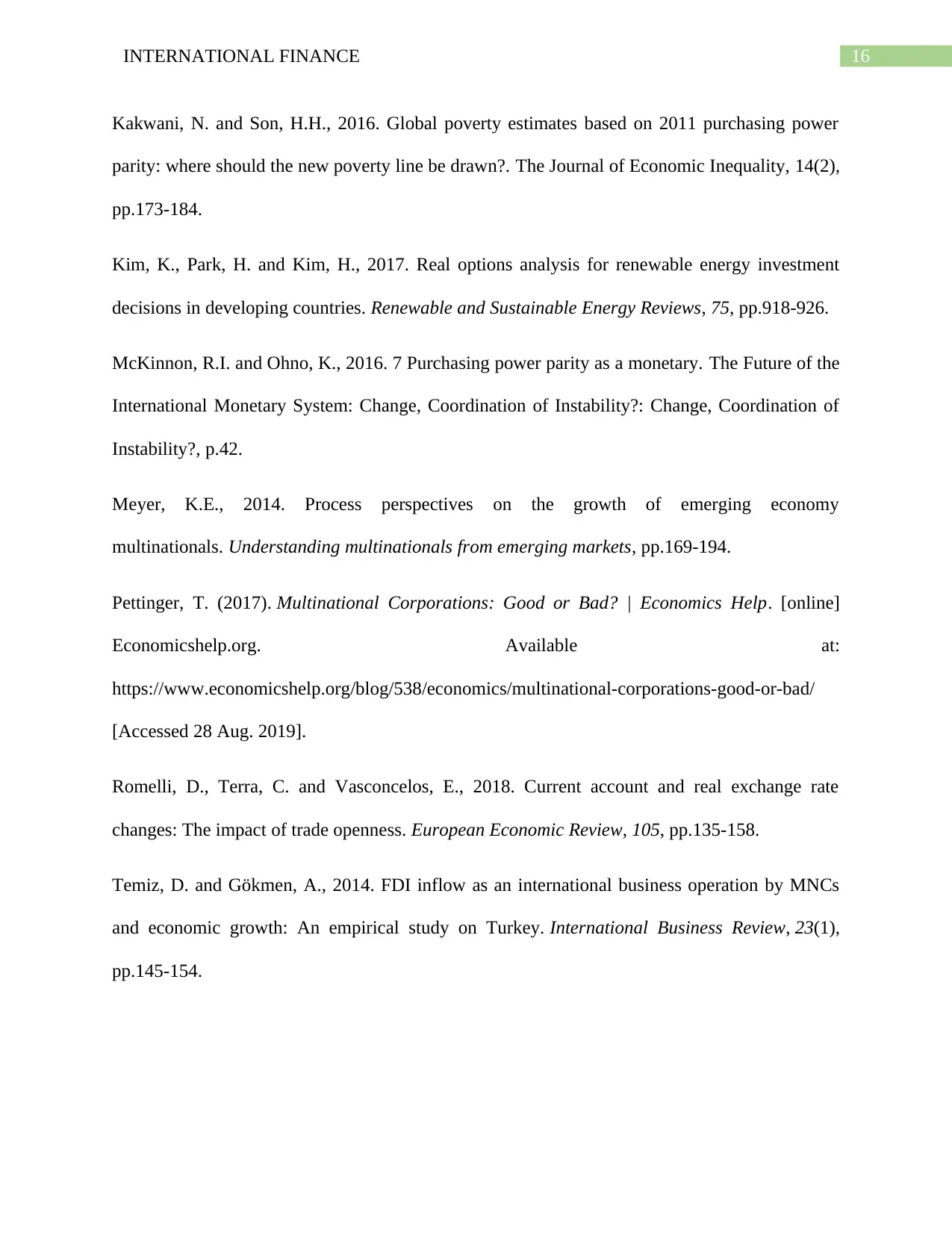
16INTERNATIONAL FINANCE
Kakwani, N. and Son, H.H., 2016. Global poverty estimates based on 2011 purchasing power
parity: where should the new poverty line be drawn?. The Journal of Economic Inequality, 14(2),
pp.173-184.
Kim, K., Park, H. and Kim, H., 2017. Real options analysis for renewable energy investment
decisions in developing countries. Renewable and Sustainable Energy Reviews, 75, pp.918-926.
McKinnon, R.I. and Ohno, K., 2016. 7 Purchasing power parity as a monetary. The Future of the
International Monetary System: Change, Coordination of Instability?: Change, Coordination of
Instability?, p.42.
Meyer, K.E., 2014. Process perspectives on the growth of emerging economy
multinationals. Understanding multinationals from emerging markets, pp.169-194.
Pettinger, T. (2017). Multinational Corporations: Good or Bad? | Economics Help. [online]
Economicshelp.org. Available at:
https://www.economicshelp.org/blog/538/economics/multinational-corporations-good-or-bad/
[Accessed 28 Aug. 2019].
Romelli, D., Terra, C. and Vasconcelos, E., 2018. Current account and real exchange rate
changes: The impact of trade openness. European Economic Review, 105, pp.135-158.
Temiz, D. and Gökmen, A., 2014. FDI inflow as an international business operation by MNCs
and economic growth: An empirical study on Turkey. International Business Review, 23(1),
pp.145-154.
Kakwani, N. and Son, H.H., 2016. Global poverty estimates based on 2011 purchasing power
parity: where should the new poverty line be drawn?. The Journal of Economic Inequality, 14(2),
pp.173-184.
Kim, K., Park, H. and Kim, H., 2017. Real options analysis for renewable energy investment
decisions in developing countries. Renewable and Sustainable Energy Reviews, 75, pp.918-926.
McKinnon, R.I. and Ohno, K., 2016. 7 Purchasing power parity as a monetary. The Future of the
International Monetary System: Change, Coordination of Instability?: Change, Coordination of
Instability?, p.42.
Meyer, K.E., 2014. Process perspectives on the growth of emerging economy
multinationals. Understanding multinationals from emerging markets, pp.169-194.
Pettinger, T. (2017). Multinational Corporations: Good or Bad? | Economics Help. [online]
Economicshelp.org. Available at:
https://www.economicshelp.org/blog/538/economics/multinational-corporations-good-or-bad/
[Accessed 28 Aug. 2019].
Romelli, D., Terra, C. and Vasconcelos, E., 2018. Current account and real exchange rate
changes: The impact of trade openness. European Economic Review, 105, pp.135-158.
Temiz, D. and Gökmen, A., 2014. FDI inflow as an international business operation by MNCs
and economic growth: An empirical study on Turkey. International Business Review, 23(1),
pp.145-154.
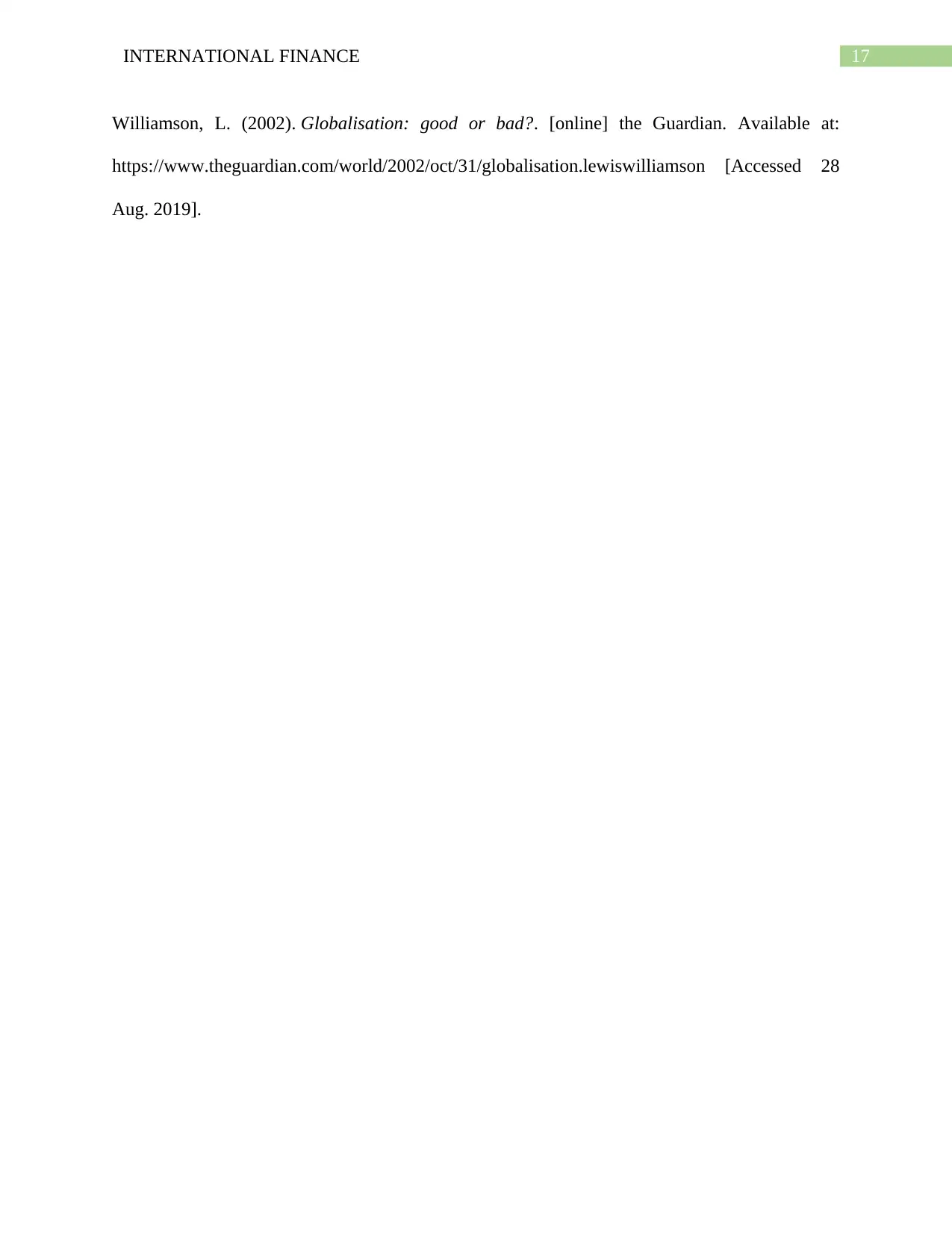
17INTERNATIONAL FINANCE
Williamson, L. (2002). Globalisation: good or bad?. [online] the Guardian. Available at:
https://www.theguardian.com/world/2002/oct/31/globalisation.lewiswilliamson [Accessed 28
Aug. 2019].
Williamson, L. (2002). Globalisation: good or bad?. [online] the Guardian. Available at:
https://www.theguardian.com/world/2002/oct/31/globalisation.lewiswilliamson [Accessed 28
Aug. 2019].
1 out of 18
Related Documents
Your All-in-One AI-Powered Toolkit for Academic Success.
+13062052269
info@desklib.com
Available 24*7 on WhatsApp / Email
![[object Object]](/_next/static/media/star-bottom.7253800d.svg)
Unlock your academic potential
© 2024 | Zucol Services PVT LTD | All rights reserved.




